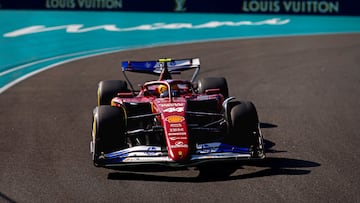DRS in F1: How it works and how many times can it be used in a race
First introduced in 2011, the Drag Reduction System continues to be a controversial topic in F1 racing to this day among fans, drivers and teams alike.


In principle, DRS is a driver-controlled device is used in order to aid in overtaking, which in turn increases the chances of wheel-to-wheel racing on the F1 circuit.
What is DRS and how does it work?
Simply put, the DRS works by opening up a space in the rear wing of the car, which in turn decreases aerodynamic drag while increasing the straight-line speed of the car. This of course, allows drivers to close on the car in front of them faster than they would normally be able to. Yet, on a technical level that means something very different all together.
The DRS uses an actuator controlling a flap in the middle of an F1 car’s rear wing that can be opened by the push of a button on the steering wheel. It’s important to note, that drivers can only use the system after they have entered a designated part of the track. These areas are referred to as DRS ‘Activation’ zones.
As explained above, the open flap reduces the rear wing’s surface area and as a result reduces aerodynamic drag, rapidly increasing the car’s velocity. Where rules are concerned, DRS usage is only allowed when the driver is within one second of the car ahead - even if the car is being lapped. Interestingly, DRS can be used at any time during practice and qualifying, but only within the set activation zones.
DRS in action
It’s interesting to note that until 2013, drivers could use DRS at any point on track to reduce drag on a qualifying run. Conversely, this resulted in many teams implementing changes to the car that were ideal for practice, but not so much so when drivers had to race wheel-to-wheel. The answer to this has been the creation of a ‘detection’ point which lies before an actual DRS zone. This is the way in which the key one-second gap between cars is measured.
In case you haven’t heard, the DRS zone is called the POWER BOOST ZONE this Las Vegas race. @Francolapinto @WilliamsRacing @Launchmode #DRSZone #LVGP #F1 #Vamos pic.twitter.com/YXMHMTa3nt
— Duracell (@Duracell) November 21, 2024
By use of electronic timing loops in the track surface, the distance between two cars is measured, such that is the trailing car is measured at a distance of less than one second behind the car in front, a signal is sent to the car at which point the driver can activate his DRS in the ensuing zone. Typically, the drivers are informed they can use DRS via dash lights activating on their steering wheels. As for the car in front, the normal practice is that the driver is contacted by his team via radio and warned that a rival is within the critical gap. At that point, the chasing driver will manually activate DRS by pressing the aforementioned button on the steering wheel and off they go.
When can DRS be used?
Before we get into when it can be used, it’s important to understand when it can’t. For starters, DRS cannot be activated during the first two laps of a race, or after standing/rolling restarts following a safety car or red flag periods. It should also be noted that FIA race director officials can disable DRS at their discretion if conditions are deemed to be unsafe – for example due to rain. A car going off track or dropped debris at a certain point can also lead to DRS being temporarily deactivated in a specific zone.
⚡F1 Car rear wing DRS activation - CFD simulation⚡
— Jousef Murad | GTM & AI Automation (@Jousefm2) February 27, 2024
The drag reduction system (DRS) is a form of driver-adjustable bodywork aimed at reducing aerodynamic drag in order to increase top speed and promote overtaking.
Simulation Owner: Luke Morgan pic.twitter.com/rT9jCnf8on
As for when it can be used, we mentioned before that it can only be utilized in ‘Activation’ zones, however, it’s important to understand how many of those zones there are. Typically, most tracks have a DRS zone on their main straight, but some have as many as three. As you can probably guess, there are a number of factors that are taken into consideration when it comes to the placing of a zone.
Related stories
At the 2025 F1 Miami Grand Prix, there are three DRS zones: the first is 90m after Turn 18, the second is 70m after Turn 16 and the third’s detection is 15m after Turn 17.


Complete your personal details to comment